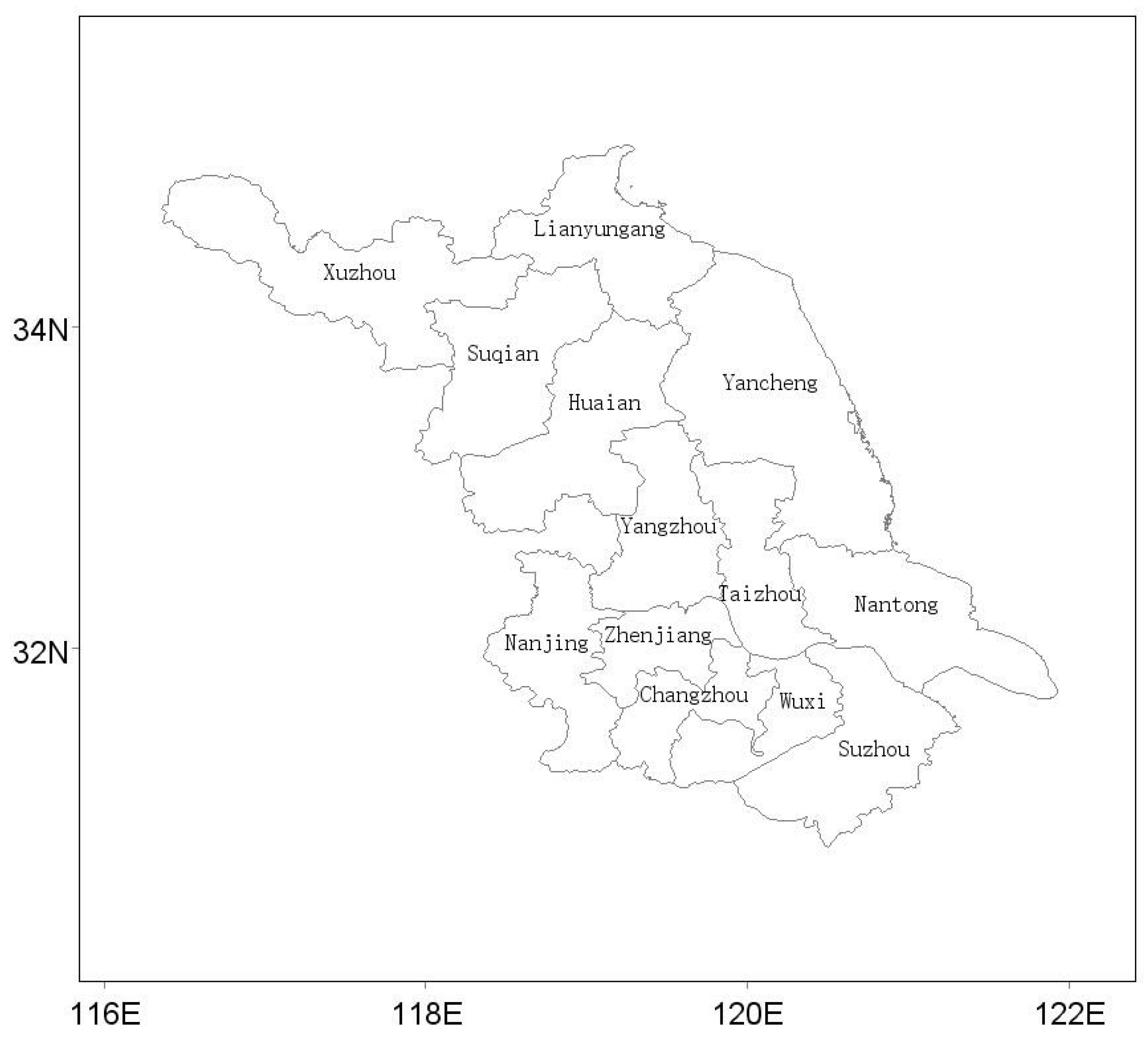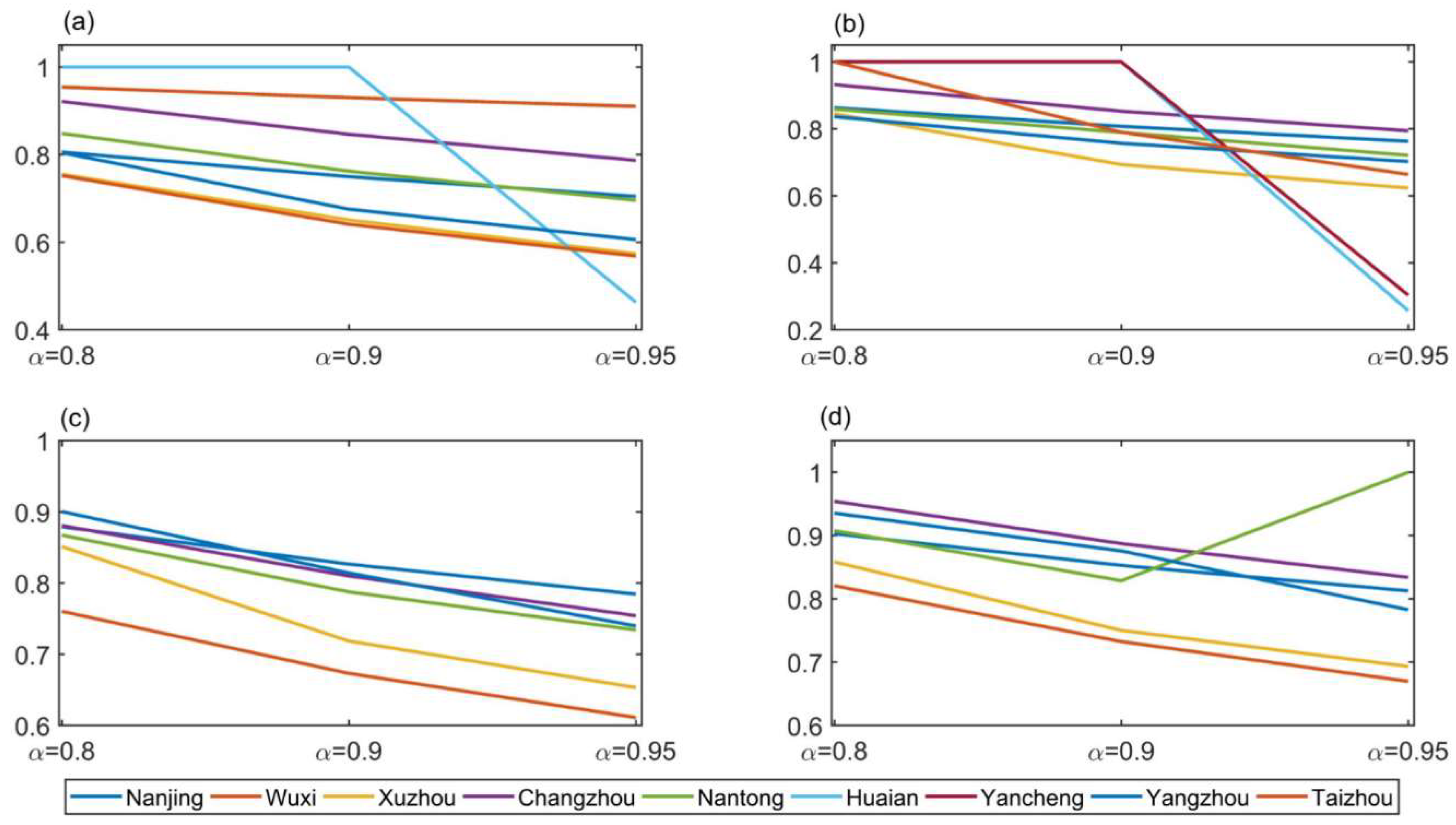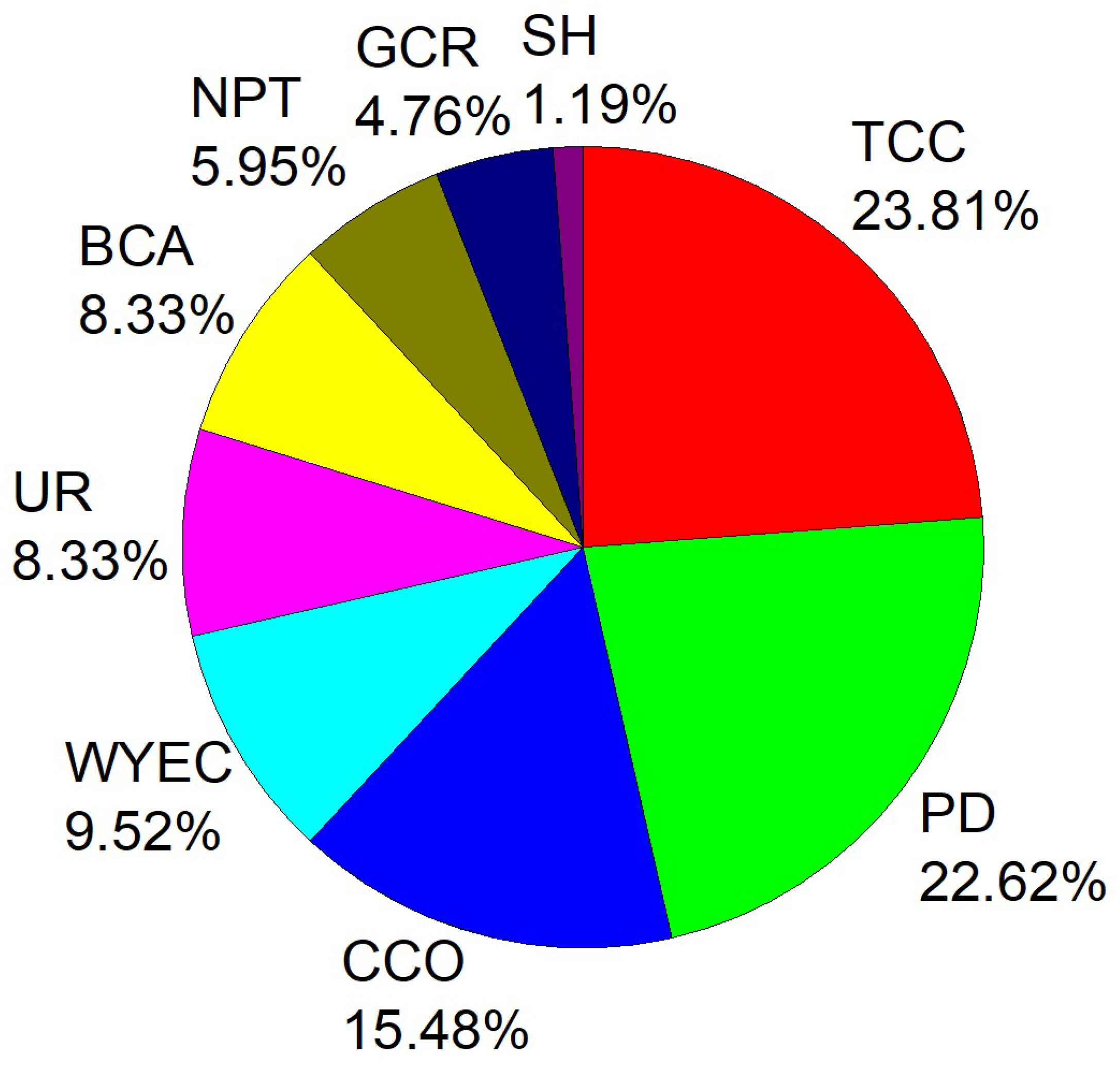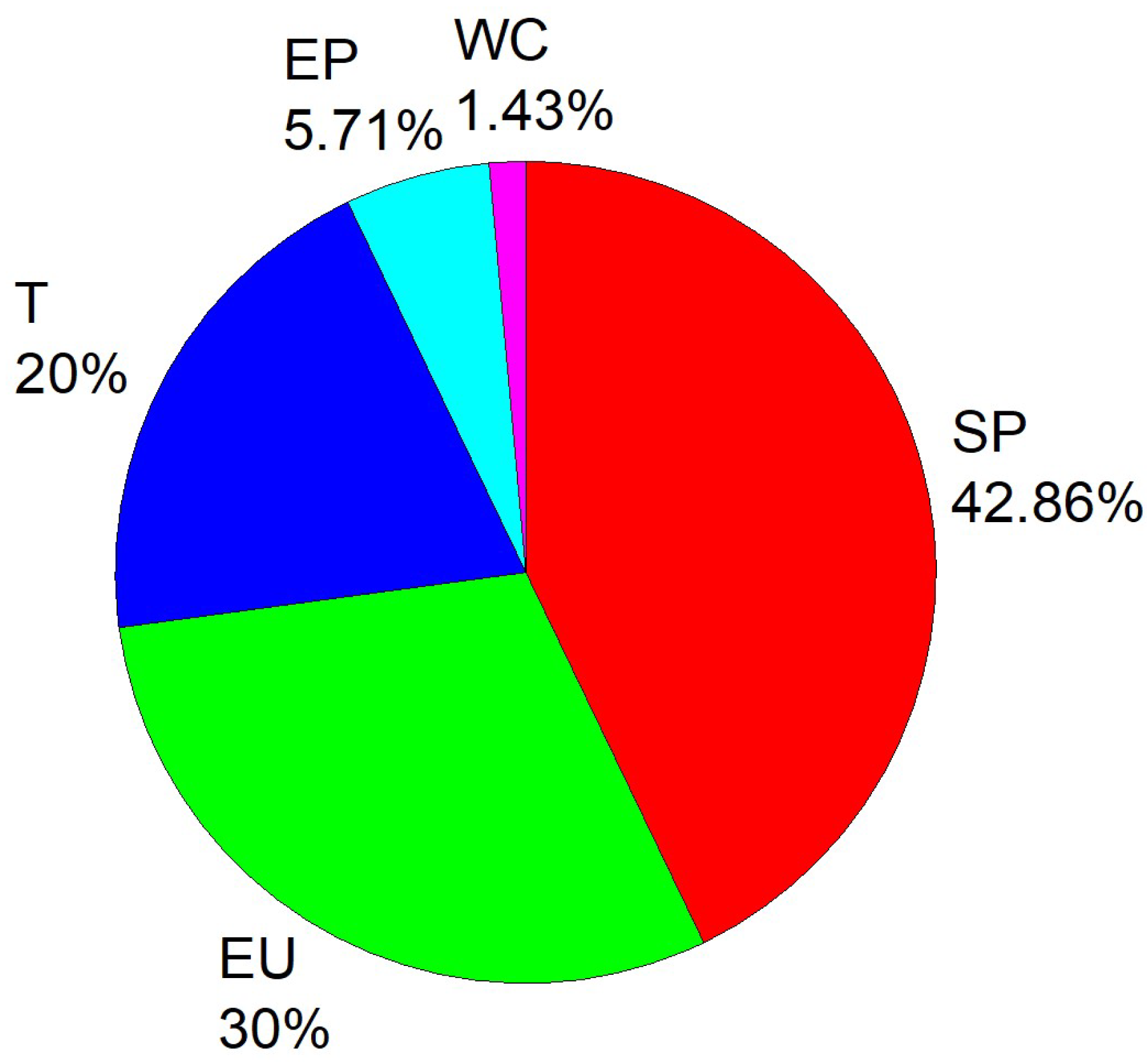Haze Influencing Factors: A Data Envelopment Analysis Approach
Abstract
1. Introduction
1.1. Human Activities
1.2. Meteorological Factors
1.3. Our Approach
2. Model and Method
- All 14 secondary indexes were used as input indicators, GDP and PM2.5 as output indicators, and chance constrained stochastic DEA was used for the calculation.
- Based on the settings of experiment I, a secondary index was deleted and the remaining 13 input indicators and 2 output indicators were used for the calculation. The purpose of this experiment was to identify which secondary input index has the greatest impact on output indicators.
- As indicators may interact with each other, considering the interrelatedness and mutual influence between indicators, and treating the same type of indexes as one group, we obtained five primary indexes. Based on the settings of experiment I, a primary index was deleted and the remaining four input indicators and two output indicators were used for the calculation. The purpose of this experiment was to identify which primary index has the greatest impact on output indicators.
- (1)
- , representing the 14 secondary indexes used in Experiment I;
- (2)
- , representing the 13 secondary indexes used in Experiment II;
- (3)
- , representing the 5 primary indexes used in Experiment III.
3. Data Sources and Indexes Explanation
3.1. Data Sources
3.2. Indexes Explanation
4. Result Analysis
4.1. Chance Constrained Stochastic DEA with All 14 Secondary Indexes as Input Indicators Subsection
4.2. Chance Constrained Stochastic DEA with 1 Secondary Index Deleted Each Time
4.3. Chance Constrained Stochastic DEA with 1 Primary Index Deleted Each Time
- (1)
- For the same year, the stochastic efficiency decreased with an increased risk level. For the same risk level, the stochastic efficiency increased with later years.
- (2)
- By deleting one secondary index at a time, we determined the secondary index (total coal consumption) that had the greatest impact on output indicators. The second largest was population density, the third largest was civil car ownership, and per 10,000 yuan gross output value of industry energy consumption was the fourth. Removal of human factors accounted for 97.94% of the total changes in stochastic efficiency. Removal of natural causes (wind speed and sunshine hours) accounted for only 2.06% of the total change. While some meteorological elements such as wind speed and temperature do have a large impact on PM2.5, we used annual data in this study and did not show this. Daily or hourly data will be more likely to show the importance of meteorological elements.
- (3)
- By deleting one primary index at a time, we found the primary index (social progress) that had the greatest impact on output indicators. The second largest was energy use, and the third largest was transportation. Removal of the human factor index accounted for 97.51% of the total changes in stochastic efficiency while removal of the weather condition index accounted for only 2.49% of the total change.
- (4)
- Human activities are deeply associated with PM2.5 pollution and the impact of meteorological factors is far less than that caused by human activities.
5. Discussion
6. Conclusions
Author Contributions
Funding
Conflicts of Interest
References
- Wu, D.; Bi, X.; Deng, X.; Li, F.; Tan, H.; Liao, G.; Huang, J. Effect of atmospheric haze on the deterioration of visibility over the Pearl River Delta. Acta Meteorol. Sin. 2007, 21, 215–223. [Google Scholar]
- Zhou, Z.; Shao, T.; Qin, M.; Miao, X.; Chang, Y.; Sheng, W.; Wu, F.; Yu, Y. The effects of autophagy on vascular endothelial cells induced by airborne PM2.5. J. Environ. Sci. 2018, 66, 182–187. [Google Scholar] [CrossRef]
- Martinelli, N.; Olivieri, O.; Girelli, D. Air particulate matter and cardiovascular disease: A narrative review. Eur. J. Int. Med. 2013, 24, 295–302. [Google Scholar] [CrossRef] [PubMed]
- Naota, M.; Shimada, A.; Morita, T.; Inoue, K.; Takano, H. Translocation pathway of the intratracheally instilled C60 fullerene from the lung into the blood circulation in the mouse: Possible association of diffusion and caveolae-mediated pinocytosis. Toxicol. Pathol. 2009, 37, 456–462. [Google Scholar] [CrossRef]
- Bai, Y.; Sun, Q. Fine particulate matter air pollution and atherosclerosis: Mechanistic insights. Biochim. et Biophys. Acta 2016, 1860, 2863–2868. [Google Scholar] [CrossRef] [PubMed]
- Xu, P.; Chen, Y.; Ye, X. Haze, air pollution, and health in China. Lancet 2013, 382, 2067. [Google Scholar] [CrossRef]
- U.S. Environmental Protection Agency. Particulate Matter (PM2.5) Trends. Available online: https://www.epa.gov/air-trends/particulate-matter-pm25-trends#pmnat (accessed on 2 July 2018).
- Ministry of Ecology and Environment of the People’s Republic of China. Report on the State of Environment in China. Available online: http://www.mee.gov.cn/hjzl/zghjzkgb/lnzghjzkgb/ (accessed on 2 July 2018).
- Maji, K.J.; Dikshit, A.K.; Arora, M.; Deshpande, A. Estimating premature mortality attributable to PM2.5 exposure and benefit of air pollution control policies in China for 2020. Sci. Total Environ. 2018, 612, 683–693. [Google Scholar] [CrossRef] [PubMed]
- Che, H.; Zhang, X.; Li, Y.; Zhou, Z.; Qu, J.J.; Hao, X. Haze trends over the capital cities of 31 provinces in China, 1981–2005. Theor. Appl. Climatol. 2009, 97, 235–242. [Google Scholar] [CrossRef]
- Ding, Y.H.; Liu, Y.J. Analysis of long-term variations of fog and haze in China in recent 50 years and their relations with atmospheric humidity. Sci. China Earth Sci. 2014, 57, 36–46. [Google Scholar] [CrossRef]
- Ministry of Ecological Environment of People’s Republic of China. Report on the State of Environment in China. Available online: http://www.mee.gov.cn/hjzl/zghjzkgb/lnzghjzkgb/201805/P020180531534645032372.pdf (accessed on 10 July 2018).
- Ministry of Ecological Environment of People’s Republic of China. Analysis of the Source of PM2.5 in Beijing. Available online: http://dqhj.mep.gov.cn/dqhjzl/dqklwyjx/201709/t20170915_421691.shtml (accessed on 14 July 2018).
- You, C.F.; Xu, X.C. Coal combustion and its pollution control in China. Energy 2010, 35, 4467–4472. [Google Scholar] [CrossRef]
- Tang, X.; Snowden, S.; Mclellan, B.C.; Höök, M. Clean coal use in China: Challenges and policy implications. Energy Policy 2015, 87, 517–523. [Google Scholar] [CrossRef]
- Cheng, M.; Zhi, G.; Tang, W.; Liu, S.; Dang, H.; Guo, Z.; Du, J.; Du, X.; Zhang, W.; Zhang, Y.; et al. Air pollutant emission from the underestimated households’ coal consumption source in China. Sci. Total Environ. 2016, 580, 641–650. [Google Scholar] [CrossRef] [PubMed]
- Xue, Y.; Zhou, Z.; Nie, T.; Wang, K.; Nie, L.; Pan, T.; Wu, X.; Tian, H.; Zhong, L.; Li, J.; et al. Trends of multiple air pollutants emissions from residential coal combustion in Beijing and its implication on improving air quality for control measures. Atmos. Environ. 2016, 142, 303–312. [Google Scholar] [CrossRef]
- Zhang, Z.; Wang, W.; Cheng, M.; Liu, S.; Xu, J.; He, Y.; Meng, F. The contribution of residential coal combustion to PM2.5, pollution over China’s Beijing-Tianjin-Hebei region in winter. Atmos. Environ. 2017, 159, 147–161. [Google Scholar] [CrossRef]
- Fang, M.; Yao, C.X. Managing air quality in a rapidly developing nation: China. Atmos. Environ. 2009, 43, 79–86. [Google Scholar] [CrossRef]
- Gao, J.; Tian, H.; Cheng, K.; Lu, L.; Zheng, M.; Wang, S.; Hao, J.; Wang, K.; Hua, S.; Zhu, C.; et al. The variation of chemical characteristics of PM2.5, and PM10, and formation causes during two haze pollution events in urban Beijing, China. Atmos. Environ. 2015, 107, 1–8. [Google Scholar] [CrossRef]
- Yang, J.; Ma, S.; Gao, B.; Li, X.; Zhang, Y.; Cai, J.; Li, M.; Yao, L.; Huang, B.; Zheng, M. Single particle mass spectral signatures from vehicle exhaust particles and the source apportionment of on-line PM2.5 by single particle aerosol mass spectrometry. Sci. Total Environ. 2017, 593, 310–318. [Google Scholar] [CrossRef]
- Gao, J.; Woodward, A.; Vardoulakis, S.; Kovats, S.; Wilkinson, P.; Li, L.; Xu, L.; Li, J.; Yang, J.; Li, J.; et al. Haze, public health and mitigation measures in China: A review of the current evidence for further policy response. Sci. Total Environ. 2017, 578, 148–157. [Google Scholar] [CrossRef]
- Goel, A.; Kumar, P. Characterisation of nanoparticle emissions and exposure at traffic intersections through fast–response mobile and sequential measurements. Atmos. Environ. 2015, 107, 374–390. [Google Scholar] [CrossRef]
- Kinsey, J.S.; Linna, K.J.; Squier, W.C.; Muleski, G.E.; Cowherd, C., Jr. Characterization of the fugitive particulate emissions from construction mud/dirt carryout. Air Repair 2004, 54, 1394–1404. [Google Scholar] [CrossRef]
- Hassan, H.A.; Kumar, P.; Kakosimos, K.E. Flux estimation of fugitive particulate matter emissions from loose Calcisols at construction sites. Atmos. Environ. 2016, 141, 96–105. [Google Scholar] [CrossRef]
- Zhao, D.; Chen, H.; Li, X.; Ma, X. Air pollution and its influencing factors in China’s hot spots. J. Clean. Prod. 2018, 185, 619–627. [Google Scholar] [CrossRef]
- Lin, B.; Zhu, J. Changes in urban air quality during urbanization in China. J. Clean. Prod. 2018, 188, 312–321. [Google Scholar] [CrossRef]
- Wu, J.; Zheng, H.; Zhe, F.; Xie, W.; Song, J. Study on the relationship between urbanization and Fine Particulate Matter (PM2.5) concentration and its implication in China. J. Clean. Prod. 2018, 182, 872–882. [Google Scholar] [CrossRef]
- Zhou, C.; Chen, J.; Wang, S. Examining the effects of socioeconomic development on fine particulate matter (PM2.5) in China’s cities using spatial regression and the geographical detector technique. Sci. Total Environ. 2018, 619–620, 436–445. [Google Scholar] [CrossRef]
- Fu, G.Q.; Xu, W.Y.; Yang, R.F.; Li, J.B.; Li, C.S. The distribution and trends of fog and haze in the North China Plain over the past 30 years. Atmos. Chem. Phys. Discuss. 2014, 14, 11949–11958. [Google Scholar] [CrossRef]
- Chambers, S.D.; Wang, F.; Williams, A.G.; Deng, X.; Zhang, H.; Lonati, G.; Crawford, J.; Griffiths, A.D.; Ianniello, A.; Allegrini, I. Quantifying the influences of atmospheric stability on air pollution in Lanzhou, China, using a radon-based stability monitor. Atmos. Environ. 2015, 107, 233–243. [Google Scholar] [CrossRef]
- Yang, S.; Ma, Y.L.; Duan, F.K.; He, K.B. Characteristics and formation of typical winter haze in Handan, one of the most polluted cities in China. Sci. Total Environ. 2017, 613–614, 1367–1375. [Google Scholar] [CrossRef]
- Li, W.; Liu, X.; Zhang, Y.; Sun, K.; Wu, Y.S.; Xue, R.; Zeng, L.; Qu, Y.; An, J. Characteristics and formation mechanism of regional haze episodes in the Pearl River Delta of China. J. Environ. Sci. 2018, 63, 236–249. [Google Scholar] [CrossRef]
- Guo, L.C.; Zhang, Y.; Lin, H.; Zeng, W.; Liu, T.; Xiao, J.; Rutherford, S.; You, J.; Ma, W. The washout effects of rainfall on atmospheric particulate pollution in two Chinese cities. Environ. Pollut. 2016, 215, 195–202. [Google Scholar] [CrossRef]
- Zhang, Y.; Yang, A.; Xiong, C.; Wang, T.; Zhang, Z. Feature selection using data envelopment analysis. Knowl.-Based Syst. 2014, 64, 70–80. [Google Scholar] [CrossRef]
- Jin, J.; Zhou, D.; Zhou, P. Measuring environmental performance with stochastic environmental DEA: The case of APEC economies. Econ. Modell. 2014, 38, 80–86. [Google Scholar] [CrossRef]
- Charles, V.; Cornillier, F. Value of the stochastic efficiency in data envelopment analysis. Expert Syst. Appl. 2017, 81, 349–357. [Google Scholar] [CrossRef]
- Olesen, O.B.; Petersen, N.C. Stochastic data envelopment analysis—A review. Eur. J. Oper. Res. 2016, 251, 2–21. [Google Scholar] [CrossRef]
- Wu, C.; Li, Y.; Liu, Q.; Wang, K. A stochastic DEA model considering undesirable outputs with weak disposability. Math. Comput. Modell. 2013, 58, 980–989. [Google Scholar] [CrossRef]
- Chen, X.; Gong, Z. DEA efficiency of energy consumption in China’s manufacturing sectors with environmental regulation policy constraints. Sustainability 2017, 9, 210. [Google Scholar] [CrossRef]
- Gong, Z.; Chen, X. Analysis of Interval Data Envelopment Efficiency Model Considering Different Distribution Characteristics—Based on Environmental Performance Evaluation of the Manufacturing Industry. Sustainability 2017, 9, 2080. [Google Scholar] [CrossRef]
- Wang, L.; Gong, Z.; Gao, G.; Wang, C. Can energy policies affect the cycle of carbon emissions? Case study on the energy consumption of industrial terminals in Shanghai, Jiangsu and Zhejiang. Ecol. Ind. 2017, 83, 1–12. [Google Scholar] [CrossRef]
- Charnes, A.; Cooper, W.W.; Rhodes, E. Measuring the efficiency of decision making units. Eur. J. Oper. Res. 1978, 2, 429–444. [Google Scholar] [CrossRef]
- Banker, R.D.; Charnes, A.; Cooper, W.W. Some models for estimating technical and scale inefficiencies in data envelopment analysis. Manag. Sci. 1984, 30, 1078–1092. [Google Scholar] [CrossRef]
- Zhang, X.Y.; Wang, Y.Q.; Niu, T.; Zhang, X.C.; Gong, S.; Zhang, Y.M.; Sun, J.Y. Atmospheric aerosol compositions in China: Spatial/temporal variability, chemical signature, regional haze distribution and comparisons with global aerosols. Atmos. Chem. Phys. 2012, 11, 26571–26615. [Google Scholar] [CrossRef]
- Lan, Y.X.; Wang, Y.M. Study of the relation between the chance constrained stochastic DEA efficiency and the risk level. J. Syst. Eng. 2014, 29, 423–432. [Google Scholar]
- China Meteorological Science Data Sharing Service Network. China Daily Climate Data Set of Ground. Available online: http://data.cma.cn/data/cdcindex/cid/6d1b5efbdcbf9a58.html (accessed on 10 July 2018).
- Statistics Bureau of Jiangsu Province. Jiangsu Statistical Yearbook. Available online: http://www.jssb.gov.cn/tjxxgk/tjsj/tjnq/nj2017/index_1508.html (accessed on 10 July 2018).
- Mitropoulos, P.; Talias, Μ.A.; Mitropoulos, I. Combining stochastic DEA with Bayesian analysis to obtain statistical properties of the efficiency scores: An application to Greek public hospitals. Eur. J. Oper. Res. 2015, 243, 302–311. [Google Scholar] [CrossRef]
- Tiao, G.C.; Box, G.E.P.; Hamming, W.J. Analysis of Los Angeles photochemical smog data: A statistical overview. J. Air Pollut. Control Assoc. 1975, 25, 260–268. [Google Scholar] [CrossRef]
- Helfand, W.H.; Lazarus, J.; Theerman, P. Donora, Pennsylvania: An environmental disaster of the 20th century. Am. J. Public Health 2001, 91, 553. [Google Scholar] [PubMed]
- Hunt, A.; Abraham, J.L.; Judson, B.; Berry, C.L. Toxicologic and epidemiologic clues from the characterization of the 1952 London smog fine particulate matter in archival autopsy lung tissues. Environ. Health Perspect. 2003, 111, 1209–1214. [Google Scholar] [CrossRef] [PubMed]
- Nemery, B.; Hoet, P.H.M.; Nemmar, A. The Meuse Valley fog of 1930: An air pollution disaster. Lancet 2001, 357, 704–708. [Google Scholar] [CrossRef]
- Brunekreef, B.; Holgate, S.T. Air pollution and health. Lancet 2002, 360, 1233–1242. [Google Scholar] [CrossRef]




| Variable | Primary Index | Secondary Index | Definition |
|---|---|---|---|
| Input | Weather Condition | Wind Speed | The velocity of air relative to a fixed place on the earth. |
| Precipitation | The amount of precipitation in a region. | ||
| Temperature | The degree of air cooling and heating. | ||
| Atmospheric Pressure | Force per unit area exerted by an atmospheric column. | ||
| Sunshine Hours | Duration of sunshine in a day. | ||
| Relative Humidity | The percentage of water vapor pressure to the saturated vapor pressure in the air. | ||
| Social Progress | Urbanization Rate | The percentage of the total population living in urban areas. | |
| Population Density | Number of people per square kilometer. | ||
| Building Construction Area | Total construction area of the buildings constructed during the reporting period. | ||
| Transportation | Civil Car Ownership | Vehicles registered under civil vehicle licenses. | |
| Number of Public Transportation Vehicles under Operation | Public transportation vehicles that serve residents, different vehicles are converted to the same standard. | ||
| Energy Use | Per 10,000 Yuan Gross Output Value of Industry Energy Consumption | The percentage of energy consumption by enterprises to the total industrial output value. | |
| Total Coal Consumption | The amount of coal consumed converted into the amount of standard coal. | ||
| Environmental Protection | Green Coverage Rate of Built-up Area | The percentage of green coverage area to built-up area. | |
| Output | Expected Output | Gross Regional Product | The market value of all final goods and services produced in a region. |
| Undesirable Output | PM2.5 | Concentration of particles in air with diameters less than or equal to 2.5 microns. |
| City | 2013 | 2014 | 2015 | 2016 |
|---|---|---|---|---|
| Nanjing | 0.7048 | 0.763 | 0.7845 | 0.8127 |
| Wuxi | 0.9102 | 1 | 1 | 1 |
| Xuzhou | 0.574 | 0.6234 | 0.6533 | 0.6933 |
| Changzhou | 0.787 | 0.7945 | 0.7542 | 0.8341 |
| Suzhou | 1 | 1 | 1 | 1 |
| Nantong | 0.6958 | 0.7211 | 0.7342 | 1 |
| Lianyungang | 1 | 1 | 1 | 1 |
| Huaian | 0.4629 | 0.2572 | 1 | 1 |
| Yancheng | 1 | 0.3037 | 1 | 1 |
| Yangzhou | 0.6061 | 0.7027 | 0.7398 | 0.7829 |
| Zhenjiang | 1 | 1 | 1 | 1 |
| Taizhou | 0.5685 | 0.664 | 0.6111 | 0.6697 |
| Suqian | 1 | 1 | 1 | 1 |
© 2019 by the authors. Licensee MDPI, Basel, Switzerland. This article is an open access article distributed under the terms and conditions of the Creative Commons Attribution (CC BY) license (http://creativecommons.org/licenses/by/4.0/).
Share and Cite
Zhou, Y.; Li, L.; Sun, R.; Gong, Z.; Bai, M.; Wei, G. Haze Influencing Factors: A Data Envelopment Analysis Approach. Int. J. Environ. Res. Public Health 2019, 16, 914. https://doi.org/10.3390/ijerph16060914
Zhou Y, Li L, Sun R, Gong Z, Bai M, Wei G. Haze Influencing Factors: A Data Envelopment Analysis Approach. International Journal of Environmental Research and Public Health. 2019; 16(6):914. https://doi.org/10.3390/ijerph16060914
Chicago/Turabian StyleZhou, Yi, Lianshui Li, Ruiling Sun, Zaiwu Gong, Mingguo Bai, and Guo Wei. 2019. "Haze Influencing Factors: A Data Envelopment Analysis Approach" International Journal of Environmental Research and Public Health 16, no. 6: 914. https://doi.org/10.3390/ijerph16060914
APA StyleZhou, Y., Li, L., Sun, R., Gong, Z., Bai, M., & Wei, G. (2019). Haze Influencing Factors: A Data Envelopment Analysis Approach. International Journal of Environmental Research and Public Health, 16(6), 914. https://doi.org/10.3390/ijerph16060914






